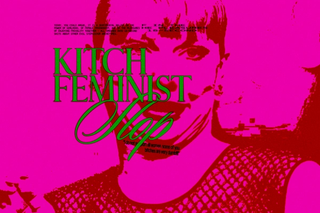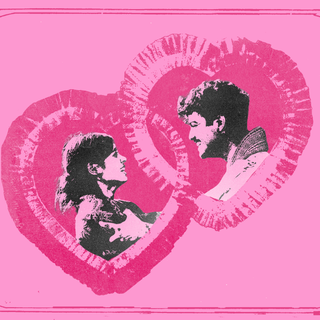
Against Kitsch Feminist Slop
Are you a girl's girl or are you the boyfriend's girl best friend? Welcome to the monoculture of algorithmically mass-produced femininity.

Every time I go to Instagram’s “For You” page, I dip into a Stepford wives-esque universe in which everybody speaks in the same register of faux intimacy. Perfectly manicured (often White) women coo in my phone from their driver seats, spilling a date story or a life hack, seemingly for my ears only. Some enact imagined scenarios where my boyfriend’s girl best friend might be trying to steal him. Some tell me about their day while applying or taking off their makeup, or they might be asking for my thoughts about their outfit. Still others pretend to be the insufferable manic pixie girl in an indie movie, which is meant to be an inside joke with me. They’re eerily similar to one another; through them, I’m subsumed into a universe with its own rules of girl’s girl etiquette.
In the early 2000s, critical theorist Lauren Berlant categorized media like this under the umbrella of “women’s culture.” At the time, women’s culture was defined by disappointment in the promise of heterosexual romance. Berlant noted that mass women’s culture is a result of the fact that “people marked by femininity already have something in common and are in need of a conversation that feels intimate, revelatory, and like a relief even when it is mediated by commodities…” Previously, the dominant, globalized sphere of women’s culture comprised things like Sex and the City, Nora Ephron movies, self-help books on the secrets of manifesting, Madonna, “chick-lit,” Cosmo’s sex tips, Bridget Jones, and so on. All well and good, even if not always really good.
Today, you could argue, it is a sentimental belief in the power of girlhood, of female friendship, and of the pleasures of enjoying frivolity together – all smashed into 15-second skits about other evil stepsister archetypes. Let’s call this (primarily online) culture feminine kitsch, or perhaps kitsch feminism.
The templatization of the “women’s culture” ethos into shortform content about other girls is, at best, boring – at worst, slop.
Kitsch, of course, could connote a good or a bad thing in art depending on whom you ask or which cultural milieu you’re in. In the 1930s, the critic Clement Greenberg pit kitsch against high art; but kitsch has since come to be seen as a value-neutral way to understand ourselves. In the digital age, you might say kitsch is simply content, or anything that’s content-coded. Which is to say, the sameness of common denominator aesthetics; what we might even recognize today as millennial cringe. Like the Camp Rock clips or this “she’s so crazzzzzzy love her” meme epitomizing the quirky woman, or Disney Adults, or their cousins Harry Potter adults. Kitsch is literally the German word for trash, and this might be more true of media today than it was when we were talking about, say, Jeff Koons or Damien Hirst or Kim Kardashian’s early aesthetic.
We also know now, however, that anything in the realm of “women’s culture” is often denigrated as trash. This has mostly been unfair; and art and film and music critics have vindicated the artistic qualities of many forms of women’s culture through serious analysis of the work that women produce in the public sphere, and how women accordingly receive said work. But the templatization of the “women’s culture” ethos into shortform content about other girls is, at best, boring – at worst, slop.
Everything we see, say, or do online, as “girlies” (gender agnostic) is produced or mediated through the language of kitschy sincerity and feminine in-groupness. The marketability project of these base feelings consequently turns them into slop. Influencers selling “girl’s girl” tees (a replacement for the “feminist” tees, perhaps, with this version declaring you’re not like the girls who are not like other girls). Others enacting ragebait skits about the conniving “girl best friend” in ads for shampoo or body lotion. Swifties calling Billie Eilish a “pick-me” for criticizing billionaires (a perceived slight against their billionaire idol). You might get called a pick-me too if you say anything critical about Swift or makeup or skincare or basically anything that apparently all of us have reclaimed. All this is great news, of course – for corporations and billionaire pop stars. Lifestyle, fashion, and beauty industries have successfully returned to their aughts-era market dominance – except where they were once marketed as sexually desirable, today they’re repackaged as good feminist manners, or better still, solidarity.
With each skit simulating the “girl who wants your boyfriend” that pops into my feed, I’m more convinced that all this is an elaborate psy-op designed to make us extremely superficial and toothless.
Most things in the “women’s culture” public sphere today thus share the same ingredients – comic exaggeration, effusive hype for one another, fond nostalgia for fictional or celebrity women considered misunderstood or villainized, ironic sexiness, sincere baddie-ness – everything distilled down to the idea that being a woman today is all about declaring it so via this particular mode of consumption and language. We’re forced to swallow a monoculture of feel-good womanhood that seems like it’s been manufactured and mass-produced algorithmically. With each skit simulating the “girl who wants your boyfriend” that pops into my feed, I’m more convinced that all this is an elaborate psy-op designed to make us extremely superficial and toothless.
Above not boding well for feminism, the greatest crime of “feminist” or feminine kitsch slop is that it is so annoying. The subtext in kitsch slop content is a certain sanctimony and smugness about being a better person, a better woman even. The people in the reels and the lengthy Substack essays and the stan wars over female popstars all subscribe to a saccharine standard of behaviour reminiscent of what you might find in a Victorian Good Ladies Handbook to Etiquette tome, where good ladies are taught the unspoken codes for how to greet, host, and enjoy harmless camaraderie with one another. In not centering men – like the many podcasts that simulate cozy sleepover-talk between adolescent girls – kitsch slop content does in fact center men.
We are constantly preoccupied with anxieties about how to conduct ourselves with each other, as women, while seemingly being above heterosexuality as a concept (it is reportedly embarrassing to have a boyfriend now). At the same time we must reject, wholesale, the women who are out to get “our” men, or who aim to please them by trying to be like them. This era is also worse because for some reason, we’ve also infantilized ourselves – notice how “girl’s girl” is the supposedly more wholesome update to “women supporting women,” except now we are meant to not understand math or finances or cold, grown up things. We’ve been divided into coalitions of women who are either with us or against us; bound together by cloying togetherness and splintered by a refusal to conform.
Feminist kitsch slop, unlike feminism itself, ends the conversation prematurely under the guise that mere kinship with fellow-women is enough.
The affective principles of feminine kitsch forget one thing: We don’t have to like all women. Unlikeable women are important because, in many instances, they reflect back at us our anxieties about performing femininity. Likeability being the default state keeps us from being honest with each other – and ourselves. I don’t always like other women by default (immortalized by one of my favourite tweets of all time: “I do not support all women. some of you bitches are very dumb!!!!”). But even saying this makes me uncomfortable and afraid. I’m growing exhausted by the algorithmic erosion of my tastes. When everything is optimized towards being perceived, the culture makes us all beholden to our mirror selves. We then end up performing for the sake of this mirror self.
A woman in a bar bathroom thanked me for sharing my perfume with her with entirely too much pathos: “omg girl you’re such a girl’s girl I love you!” Another time, the term “pick-me final boss” found its way into a gossip session with a friend, referring to a mutual acquaintance’s Instagram post. Before long, these silly terms – whether it is the overly affective forms of meaningless praise or put-downs for women who make us uncomfortable – replace traditional warmth and/or bitchiness by adding a layer of sanctimoniousness (earlier, we could just admit to ourselves that we irrationally dislike someone without making it a whole thing). Is this what The Man wants, making us reduce one another as soul sisters or man-snatchers?
Sianne Ngai posited three aesthetic categories that dominate postmodern media culture at any given point: cute, zany, interesting. They’re “non-cathartic” feelings in that they don’t provoke any strong action or culminate in something definitive. Feminine kitsch slop – and its resultant behavioural influences – is a stew of all three: the commodities are cute, the vibe is zany, the discourse is superficially interesting. But we’re left with no directive, nothing to work towards, to finish or aim for or even say. Feminist kitsch slop, unlike feminism itself, ends the conversation prematurely under the guise that mere kinship with fellow-women is enough.
Feminine kitsch slop makes us overlook the ongoing commodification of women in popular culture – except this time they’re packaged as your older sister, your best friend, the girl’s girl who will never let you down, the cool girl who gives you permission to be sexy, to party, to bedrot, to do anything you want.
Berlant goes on to say that our consumption of women’s culture is “a way of experiencing one’s own story as part of something social, even if one’s singular relation to that belonging is extremely limited, episodic, ambivalent, rejecting, or mediated by random encounters with relevantly marked texts.” Which is to say, nothing about the slop in my algorithm has anything to do with me, but parts of my speech and thinking, even in real life, is somehow guided by its dictates. A colleague received a death threat for a critical comment about Taylor Swift (whose person and fandom are arguably patient zeroes of kitsch feminist slop). I’ve privately nursed hurt from comments calling to have me fired for having a take on Sally Rooney once. An acquaintance (half) joked that I’m a pick-me for hating Kareena Kapoor in K3G. Kitsch is supposed to be fun, but it isn’t at all when it stifles one’s presence and subjectivity – incentivizing people to either engage in hyperpositivity, or to leave.
All this is evident – and imposes itself – both in the making and in the interpretation of art by women. You must effusively praise all the new women director’s movies and women’s sports; disliking any woman pop artist is anathema to the moral universe of girl’s girlhood, and everything is 15-second skit paradise in the form of mocking the “insufferable female lead” in some generic old movie to feel good about ourselves. But there comes a point when the “aesthetic odiousness,” as critic Becca Rothfield put it, is indicative of “moral rot.” Feminine kitsch makes us overlook the ongoing commodification of women in popular culture – except this time they’re packaged as your older sister, your best friend, the girl’s girl who will never let you down, the cool girl who gives you permission to be sexy, to party, to bedrot, to do anything you want. You’ll consume different versions of all these avatars until your brain feels emptied out of intellectual juice. We’re only legitimately allowed to be disagreeable when it’s against something, or someone, that disturbs the peace. Our bra-burning, pitchfork wielding, resistance fighting, intellectually subversive ancestors would be so disappointed. But maybe they were never girl’s girls, am I right ladies?
Rohitha Naraharisetty is a Senior Associate Editor at The Swaddle. She writes about the intersection of gender, caste, social movements, and pop culture. She can be found on Instagram at @rohitha_97 or on Twitter at @romimacaronii.
Related


The End of the Marriage Plot
